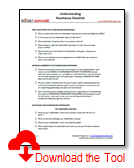
In your role as a leader, you will likely encounter resistance to change at some point from one or more of your own team members. Resistance may come from a variety of sources:
- An individual with a difficult personality
- Someone anxious about impending change
- A person who disagrees with your vision
Resistance is usually demonstrated in one of four ways, each with the potential to create roadblocks for you:
- Lack of Communication – Leaving you out of the loop in terms of key information or not discussing issues openly
- Lack of Support – Foot-dragging on key initiatives you try to implement
- Counterproductive Criticism – Being overly critical of you and your ideas
- Passive Aggressive Behavior – Agreeing to do something, but then not doing anything
Overt & Covert Resistance Action Steps
Resistance may be expressed directly (overt) or indirectly (covert). Overt resisters may be quite open with you or others about their discontent. Covert resisters, on the other hand, may behave in a passive-aggressive manner, agreeing with you verbally but participating half-heartedly or ineffectively with no real commitment. Although overt and covert resistance each present unique challenges, the best way to tackle either is to be prepared to encounter them. Be curious about their causes and direct in identifying them to the resister.
Here are a few practical steps you can take as a leader to address change resistance within your team:
- Be alert to signs of resistance, and meet with the resister if it begins to create problems. Use active listening to gather information and gain an understanding of the employee’s perspective. Listening and showing that you understand a point of view do not mean you agree with a given behavior. Act as a “mirror” to the person, and point out your observations.
- Without criticizing, identify the roadblocks you have observed.
- Seek the individual’s perceptions of the situation.
- Invite the resister to share any concerns. What would he or she like to see done differently?
- Share your perspective and provide the individual with descriptive feedback about the impact of the behavior on the team and on you.
- Define the positive behaviors you want to see, and be clear about your expectations.
- Let the individual know that you want him/her to be part of the team and that you will value his/her contributions.
- If the resistance becomes habitual and impacts the individual’s performance or the performance of the team, take appropriate action. One of the most frequent mistakes is waiting too long before taking action with resisters. The longer you wait before getting consultation about addressing the resistant behavior, the more difficult that behavior will be to change. Options include:
- Consult your Human Resources department. Find out about the organization’s positive discipline process.
- Give the individual every opportunity to adopt a more constructive approach.
- By the time you have been in the position eight to ten months, you need to make a decision on the appropriate action regarding the resistant employee if the resistant behavior continues.
Understanding Resistance & Planning Your Response
 Resistance is often a natural response to the stress of change. Use this Understanding Resistance Checklist tool to help you understand whatever resistance you encounter and address it in a positive, direct, and supportive manner.
Resistance is often a natural response to the stress of change. Use this Understanding Resistance Checklist tool to help you understand whatever resistance you encounter and address it in a positive, direct, and supportive manner.
- It may be useful to debrief with someone in Human Resources and/or with your supervisor regarding any discussions with unsuccessful candidates or resisters.
- Follow through on any career development issues you discussed with the unsuccessful candidates for your role.
Want More Tools & Techniques?
This content is a sample of the 21 Management Skills and 46 Management Tools included in the Rocket Manager leadership development program.
Rocket Manager an online toolkit that helps you excel in your management role. The program condenses our 20 years of working with leaders at Fortune 500, mid-sized, and small companies. We developed this program to make “insider” knowledge, techniques, and tools accessible to leaders everywhere.












